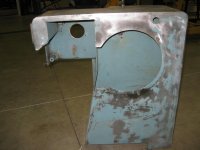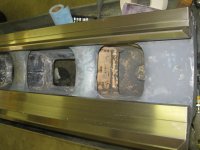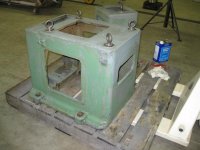Who are the furry four legged inspectors keeping an eye on your work?
The yellow lab in this set of pictures was Bandit. The brown mix seen in earlier pictures is Bud. He’s a Coon Dog, Australian Shepard, Blue Heeler mix – or in short, a Texas cattle dog. (His dad was an actual working cattle dog – although Bud’s never worked cattle.) The two you haven’t seen are Cinch, an Australian Shepard, and Capitan, a female black lab mix. (The neighborhood kids named her that. I actually haven’t named any of them.)
All of these were dogs from the neighborhood who found their way to my shop at one time or another.
Bandit never really belonged to anyone but was always rather independent. He had rounds that he would make every day, and no one knew for sure how far he went. We heard stories from people who had met Bandit miles away. Occasionally he went by other names. About 1.5 miles down the road from me is an industrial park. At lunch time, when the guys ate their lunches outside in the shade, Bandit would join them and look for a handout. But he usually made his way back to my shop each evening.
I’ll tell one more story because it occurred about the time of this rebuild. My shop is about 5,000 sf. It is divided in the middle by a wall that has a large overhead door and one walkthrough door. The remainder of the six other overhead doors are positioned around the outer walls of the shop. During the summers I keep several of the outer doors open and I position two slow moving fans in the north and south doorways. When the weather is warm, you could always find the four dogs stretched out in front of one of those fans.
I keep a box of Milk Bones (i.e. dog treats) on my desk. I noticed for the better part of a week that I was missing some, even spotting some crumbs. I thought maybe a rat. One afternoon while I was sitting at my desk and the dogs were stretched out, Bandit and I caught a glimpse of something moving in the shop. The alarm was sounded, and the chase was on. It was a small cat. I tried to collect the dogs to let the cat get away but was always too slow and too late. The chase would move on. At one point, I thought the cat had met his end between a Southbend Heavy 10 and the wall. They had cornered him. I had no idea cats could move that fast vertically. And the chase was on again.
I eventually solved this by closing the doors between the shop and isolating the dogs. The cat must have escaped through one of the open doors. Any way I never saw him again.
I felt sorry for the cat. I mean, how desperate do you have to be to take up residence in a shop with four big dogs. It is funny now – not so much then.






 . Not the first time these forums have helped sell stuff.
. Not the first time these forums have helped sell stuff.




























